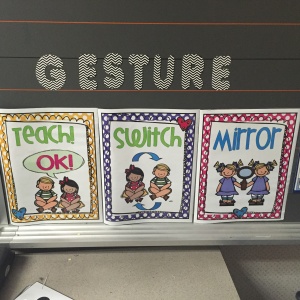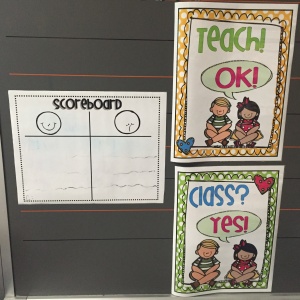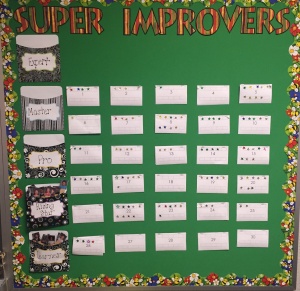Classroom Methods Help to Engage Students in the Material
“How do you have so much control in your classroom?” “How do you get 100% student participation?” “How do you activate the whole brain when teaching students?” These are some questions that can be answered by Whole Brain Teaching. Whole Brain Teaching is a high energy, highly motivational type of teaching created by three teachers in California: Chris Biffle, Jay Vanderfin, and Chris Rekstad. WBT includes fun lesson plans, rigorous discipline, and tight organization. Whole Brain Teaching intentionally activates the whole brain to increase instructional time and instructional learning. WBT is all about the teachers and students being quick, highly energetic, and in sync. Teachers on focused on increasing instructional time and students are focused on learning and having fun. The best part about WBT is that you can modify any strategies and make up new strategies to fit the needs of your learners and to spice up hold tactics. These are some of the tactics that WBT has to offer: classroom management and fast transitional strategies, every student response strategies, and super improver reinforcement.
To begin, classroom management, pace, and expectations are taught during the presentation of classroom rules. Students are taught five classroom rules and gestures. The teacher will say and gesture each rule, and the students repeat each rule. The teacher makes sure to make the words and gestures quick to set the expectation. The teacher also sets the expectation of eyes on the teacher and hands in the lap. This creates a game in itself. The game is called “Class, yes.” When the teacher shouts quickly, “Class,” the students respond quickly, “Yes!” The teacher sets the expectation that responses are always quick. The other expectations include students leaning their bodies in, ears are listening, and hands are in the lap indicating that they are ready for the next step of the lesson. These are transitions within a lesson and the are not just happening between content lessons. When 100% of the students are ready to listen, respond, and answer, “Yes!” quickly, the teacher will give them a tally on the smiley side of scoreboard. When the teacher does not receive 100% of students ready to listen, respond and answer, then the class is awarded a sad smiley. Quickly, the teacher tries again, and student redeem themselves to earn another smiley tally. The reward in end is all pride. The game, “Class, yes” and Scoreboard can be modified to keep the class quick, highly disciplined, and motivated throughout the whole year.
Next, the whole brain teacher can use Every Student Response strategies, so that all students are responding to text and questions, not just one student at a time. These strategies also include gestures because as stated as before, we want the whole brain to work. Here are some WBT Every Student Response strategies to get students thinking, moving, and talking. First, Teacher claps and shouts, “Mirror!” Student clap and respond, “Mirror, Words!” This indicates that whatever the teacher says and however he /she says it, the student will repeat it the exact same way using the exact same gestures. This is used when learning a new concept or skills and can be used during whole group readings. Next, the teacher claps and shouts, “Teach!” Student clap and respond, “OK!” This indicates that students have been given something to discuss with a partner. Students are either repeating new vocabulary terms with gestures, responding to text, or sharing ideas based on new concepts. Sometimes the teacher makes sure both partners are sharing. The teacher shouts, “Switch!” and students who are talking allow their partners to share. Another engaging activity that activates everyone’s response is called, “Yes/No way.” This is a nonverbal Every Student Response. The teacher will pose a yes or no question, and students will respond nonverbally with a yes or no gesture. This prompts the teacher to call on a student to justify using their “because clapper”, or students may share their justifications with partners. Lastly, teachers can play the QT test. This is also nonverbal. The students are prompted to cover their eyes, and put a thumbs up or a thumbs down in response to true/false or yes/no types of questions. This strategy is used before moving onto independent practice. It is an informal assessment of knowledge to gage the content learned. These are some of the basic Every Student Response strategies that Whole Brain Teaching has to offer.
Furthermore, Whole Brain teaching is driven by positive reinforcement. Throughout a lesson students are asking questions, reading, answering questions, writing, and solving problems. The teacher should always be rewarding students. One way to positively reward tasks and responses by individual students is called the, “Ten Finger Woo.” Teacher will say, “Give ____ the ten figure woo for ______.” Students quickly say, “Woo!” That student feels instant pride and will continue to do well during the lesson. Also, as stated before, students are rewarded when transitions and movements are quick and 100% of the students are focused and engaged using “Class, yes!” and Scoreboard. When students are thinking, talking, and moving quickly, more learning is happening because instructional time is increased and there is no time for unwanted behavior. Whole Brain Teaching also includes implementing what’s called a Super Improver Wall. Students have a sticker chart displayed on a wall. When a student improves in content or behavior, the student earns a sticker. Like everything else in Whole Brain Teaching, little improvements happen quickly and they should not go unnoticed. Therefore there are tiers of growth for super improvers. Things that can be improved include: motor and gross skills, content skills, behavior skills, daily tasks, spelling, handwriting, and social skills. Any small or big improvement should be awarded with a sticker. Children of all ages feel good when they are reinforced, and they feel motivated to continue doing well.
So how do you get started? First you may checkout the website, <www.wholebrainteaching.com>. This website includes first steps, vidoes, free ebooks, and many strategies discussed and many more. You may also visit the Whole Brain Teaching Facebook page that include fast support, new videos, and conference schedules. I can not say enough, how WBT has changed my life as an teacher. My classroom is fast paced, highly organized, kinesthetic, energetic, and disciplined and yours can be too!
Challenges or Obstacles
- There are lots of Whole Brain strategies. A teacher may feel overwhelmed with all the new practices. As well, some teachers may like their old way of teaching and disciplining; they may not have an open mind to incorporate them into their classrooms.
- Teachers should also know, it takes a few years to become a skilled and confident Whole Brain Teacher. The first attempt does not judge the outcome of a whole brain classroom. Some teachers may say that it didn’t work. However, the teacher should try it multiple times before giving up because it really does work if done correctly!
- Also, teachers should not attempt lots of different strategies all at the same time. The teacher should get comfortable with one strategy or practice before moving onto another.
- Last, it important to know that sometimes, teachers get stuck and stop after they practice a strategy like, “Class, Yes!” and Scoreboard, but he/she has to keep modifying the strategy in order to keep your classroom engaged and motivated.
Benefits and Successes:
- Benefits include increased instructional time and 100% student engagement.
Additional Information:
Examples of Whole Brain Teaching



Submitted by: Lauren Barthelmes and Danielle Rausch, Rhoades Elementary School
